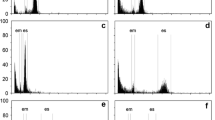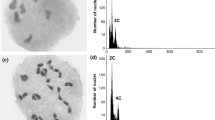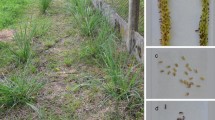Abstract
Apomixis is a widespread alternative mode of sexual reproduction resulting in offspring that are genetically identical to the maternal plant. Boehmeria tricuspis (Hance) Makino is a perennial, wind-pollinated, herbaceous plant in the nettle family Urticaceae. The diploid B. tricuspis is monoecious but the triploid B. tricuspis is gynoecious, bearing female inflorescences only. Apomixis in B. tricuspis was first reported 50 years ago, but the mode of apomixis in the species has not been described yet. Here, we provide embryological observations of the embryo sac formation proving that triploid B. tricuspis reproduced apomictically following the Antennaria type of diplospory, and that the diploid individuals were the sexual genotype with the classical Polygonum-type maturation pattern of embryo sac development. A subsequent flow cytometry seed screen (FCSS) showed that the triploids were obligate apomicts with autonomous endosperm development, and the diploids reproduced sexually. In addition, a progeny test by molecular marker assays further demonstrated the above results.
Similar content being viewed by others
References
Albertini E, Marconi G, Reale L, Barcaccia G, Porceddu A, Ferranti F, Falcinelli M (2005) SERK and APOSTART: Candidate genes for apomixis in Poa pratensis. Plant Physiol 138: 2185–2199
Asker SE, Jerling L (1992)) Apomixis in plant. CRC Press, Boca Raton, FL
Barcaccia G, Albertini E (2013)) Apomixis in plant reproduction: a novel perspective on an old dilemma. Plant Reprod 26:159–179
Calzada J-PV, Crane CF, Stelly DM (1996)) Apomixis: the asexual revolution. Science 274:1322–1323
Crane CF (2001)) Classification of apomictic mechanisms. In Y Savidan, JG Carman, T Dresselhaus, eds, The flowering of apomixis: from mechanisms to genetic Engineering. CIMMYT and IRD, Mexico, pp 24–34
Galbraith DW (2009)) Simultaneous flow cytometric quantification of plant nuclear DNA contents over the full range of described angiosperm 2C values. Cytom Part A 75:692–698
Gao C, Xin P, Cheng C, Tang Q, Chen P, Wang C, Zang G, Zhao L (2014)) Diversity analysis in Cannabis sativa based on largescale development of expressed sequence tag-derived simple sequence repeat markers. PLoS One 9: e110638
Grossniklaus U, Vielle-Calzada JP, Hoeppner MA, Gagliano WB (1998)) Maternal control of embryogenesis by MEDEA, a polycomb group gene in Arabidopsis. Science 280:446–450
Hand ML, Koltunow AM (2014)) The genetic control of apomixis: asexual seed formation. Genetics 197:441–450
Hanna WW (1995)) Use of apomixis in cultivar development. Adv Agron 54:333–354
Köhler C, Kohler C, Hennig L, Bouveret R, Gheyselinck J, Grossniklaus U, Gruissem W (2003)) Arabidopsis MSI1 is a component of the MEA/FIE polycomb group complex and required for seed development. EMBO J 22:4804–4814
Koltunow AM (1993)) Apomixis: embryo sacs and embryos formed without meiosis or fertilization in ovules. Plant Cell 5:1425–1437
Leblanc O, Grimanelli D, González-de-León D, Savidan Y (1995a)) Detection of the apomictic mode of reproduction in maize-Tripsacum hybrids using maize RFLP markers. Theor and Appl Genet 90:1198–1203
Leblanc O, Peel MD, Carman JG, Savidan Y (1995b)) Megasporogenesis and megagametogenesis in several Tripsacum species (Poaceae). Am J Bot 82:57–63
Lovell JT, Aliyu OM, Mau M, Schranz ME, Koch M, Kiefer C, Song B-H, Mitchell-Olds T, Sharbel TF (2013)) On the origin and evolution of apomixis in Boechera. Plant Reprod 26:309–315
Maheshwari P (1950)) An Introduction to the Embryology of Angiosperms. McGraw-Hill Book Co., New York
Matzk F, Meister A, Schubert I (2000)) An efficient screen for reproductive pathways using mature seeds of monocots and dicots. Plant J 21:97–108
Luo M, Bilodeau P, Koltunow A, Dennis ES, Peacock WJ, Chaudhury AM (1999)) Genes controlling fertilization-independent seed development in Arabidopsis thaliana. Proc Natl Acad Sci USA 96:296–301
Murray MG, Thompson WF (1980)) Rapid isolation of high molecular weight plant DNA. Nucleic Acids Res 8:4321
Nogler GA (1984)) Gametophytic apomixis. In BM Johri, eds, Embryology of angiosperms. Springer, Berlin, pp 475–518
Noyes RD, Baker R, Mai B (2007)) Mendelian segregation for twofactor apomixis in Erigeron annuus (Asteraceae). Heredity 98: 92–98
Ohad N, Yadegari R, Margossian L, Hannon M, Michaeli D, Harada JJ, Goldberg RB, Fischer RL (1999)) Mutations in FIE, a WD polycomb group gene, allow endosperm development without fertilization. Plant Cell 11:407–415
Okabe S (1963)) Apomixis in the genus Boehmeria. Sci Rep Tohoku Uni 4:207–215
Okada T, Hu Y, Tucker MR, Taylor JM, Johnson SD, Spriggs A, Tsuchiya T, Oelkers K, Rodrigues JCM, Koltunow AM (2013)) Enlarging cells initiating apomixis in Hieracium praealtum transition to an embryo sac program prior to entering mitosis. Plant Physiol 163:216–231
Pupilli F, Barcaccia G (2012)) Cloning plants by seeds: Inheritance models and candidate genes to increase fundamental knowledge for engineering apomixis in sexual crops. J Biotechnol 159:291–311
Qiu C, Zang G (2013)) Study on chromosome behavior of polyploidy apomictic Boehmeria tricuspis. J Plant Genet Resour China 14:577–580
Rodrigues JCM, Okada T, Johnson SD, Koltunow AM (2010)) A MULTICOPY SUPPRESSOR OF IRA1 (MSI1) homologue is not associated with the switch to autonomous seed development in apomictic (asexual) Hieracium plants. Plant Sci 179:590–597
Rodrigues JCM, Tucker MR, Johnson SD, Hrmova M, Koltunow AM (2008)) Sexual and apomictic seed formation in Hieracium requires the plant polycomb-group gene FERTILIZATION INDEPENDENT ENDOSPERM. Plant Cell 20:2372–2386
Selva J-P, Pessino SC, Meier MS, Echenique VC (2012)) Identification of candidate genes related to polyploidy and/or apomixis in Eragrostis curvula. Am J Plant Sci 03:403–416
Sharbel TF, Voigt ML, Corral JM, Galla G, Kumlehn J, Klukas C, Schreiber F, Vogel H, Rotter B (2010)) Apomictic and sexual ovules of Boechera display heterochronic global gene expression patterns. Plant Cell 22:655–671
Silveira ED, Guimaraes LA, de Alencar Dusi DM, da Silva FR, Martins NF, do Carmo Costa MM, Alves-Ferreira M, de Campos Carneiro VT (2012)) Expressed sequence-tag analysis of ovaries of Brachiaria brizantha reveals genes associated with the early steps of embryo sac differentiation of apomictic plants. Plant Cell Rep 31:403–416
van Dijk PJ, van Baarlen P, de Jong JH (2003)) The occurrence of phenotypically complementary apomixis-recombinants in crosses between sexual and apomictic dandelions (Taraxacum officinale). Sex Plant Reprod 16:71–76
Yahara T (1983)) A biosystematic study on the local populations of some species of the genus Boehmeria with special reference to apomixis. J Faculty Sci, Tokyo Uni Sect 3:217–261
Yahara T (1986)) Distribution of sexual and agamospermous populations of Boehmeria sylvestrii and its three relatives (Urticaceae). Memoirs of the Natl Sci Museum, Tokyo 19:121–132
Yahara T (1990)) Evolution of agamospermous races in Boehmeria and Eupatorium. Plant Spec Biol 5:183–196
Zang G, Zhao L, Sun J (1997)) Cytoembryological studies on apomixis in Boehmeria silvestrii. Acta Bot Sin 39:210–213
Zhao L, Zang G (1997)) Induction of male flowering in gynoecious apomictic species in Boehmeria. Plant Fiber Sci China 2:5–8
Author information
Authors and Affiliations
Corresponding author
Rights and permissions
About this article
Cite this article
Tang, Q., Zang, G., Zhao, L. et al. Embryological and genetic evidence of amphimixis and apomixis in Boehmeria tricuspis . J. Plant Biol. 59, 114–120 (2016). https://doi.org/10.1007/s12374-016-0518-1
Received:
Accepted:
Published:
Issue Date:
DOI: https://doi.org/10.1007/s12374-016-0518-1




